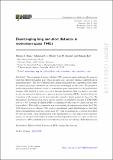Disentangling long and short distances in momentum-space TMDs
Author(s)
Ebert, Markus A.; Michel, Johannes K. L.; Stewart, Iain W.; Sun, Zhiquan
Download13130_2022_Article_18778.pdf (5.285Mb)
Publisher with Creative Commons License
Publisher with Creative Commons License
Creative Commons Attribution
Terms of use
Metadata
Show full item recordAbstract
Abstract
The extraction of nonperturbative TMD physics is made challenging by prescriptions that shield the Landau pole, which entangle long- and short-distance contributions in momentum space. The use of different prescriptions then makes the comparison of fit results for underlying nonperturbative contributions not meaningful on their own. We propose a model-independent method to restrict momentum-space observables to the perturbative domain. This method is based on a set of integral functionals that act linearly on terms in the conventional position-space operator product expansion (OPE). Artifacts from the truncation of the integral can be systematically pushed to higher powers in ΛQCD/kT. We demonstrate that this method can be used to compute the cumulative integral of TMD PDFs over
k
T
≤
k
T
cut
$$ {k}_T\le {k}_T^{\mathrm{cut}} $$
in terms of collinear PDFs, accounting for both radiative corrections and evolution effects. This yields a systematic way of correcting the naive picture where the TMD PDF integrates to a collinear PDF, and for unpolarized quark distributions we find that when renormalization scales are chosen near
k
T
cut
$$ {k}_T^{\mathrm{cut}} $$
, such corrections are a percent-level effect. We also show that, when supplemented with experimental data and improved perturbative inputs, our integral functionals will enable model-independent limits to be put on the non-perturbative OPE contributions to the Collins-Soper kernel and intrinsic TMD distributions.
Date issued
2022-07-20Department
Massachusetts Institute of Technology. Center for Theoretical PhysicsPublisher
Springer Berlin Heidelberg
Citation
Journal of High Energy Physics. 2022 Jul 20;2022(7):129
Version: Final published version